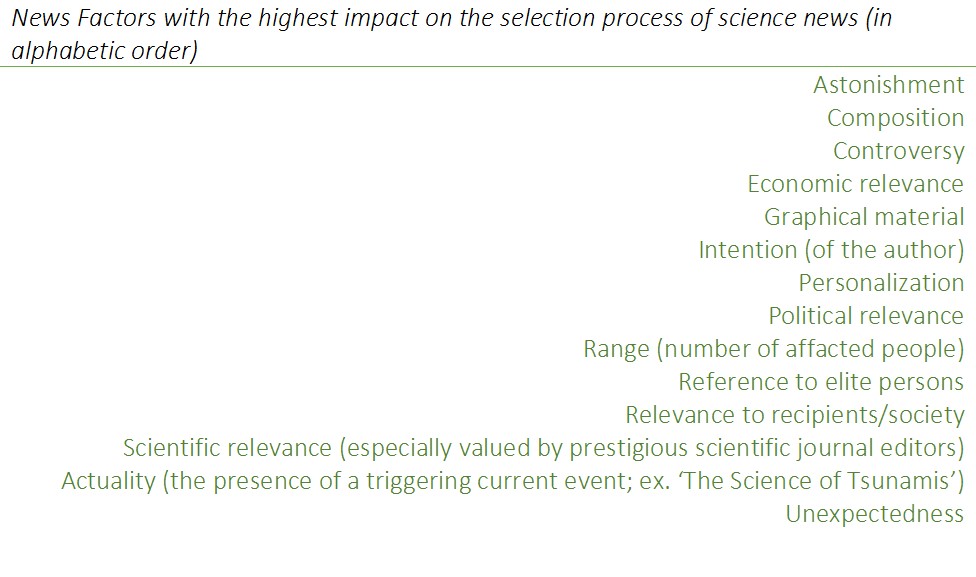What makes science newsworthy?
“What was it about this particular scientific study, as opposed to the hundreds of other important scientific findings published each week, that made it news?” - Susan M Fitzpatrick
What makes science news? What science is considered newsworthy?
This is essentially one broad topic of my PhD research. It’s an interesting question though, because it has so many dimensions. First, to whom? Because perhaps traditional science journalists have different ideas of what science is newsworthy than non-traditional science writers (e.g. science bloggers) do. Second, how do we define newsworthiness, or even news for that matter? I mean, what is news? And how are modern news media formats (newer digital platforms that close the gap between journalists and readers, for example) and social media platforms changing what we consider to be “newsworthy”? And is newsworthiness even something that science news reporters get to decide anymore? Because increasingly, the reader decides the prominence of a particular science story by sharing, re-tweeting, pinning, re-blogging, up-voting and otherwise rating the content.
Controversial. “Cool.” A famous scientist. A scientific finding highly relevant to everyday life. “Hot Button” ideas or concepts whose time has come, like cybersecurity or robotics or “hijacking and moving a brain tumor using nano wires”. Snappy headlines. Beautiful graphics. Science research tied to current events (even I’m guilty of tying research to “twerking”, ha!)
These are all clues as to what is considered newsworthy in science – or, in other words, what the news media is likely to pick up from the scientific research community. Traditionally, science has been considered newsworthy if it is unusual, bizarre, controversial, relevant to day-to-day life or more generally just plain “cool”. Examples might include hotly debated topics (see stories about vaccines, stem cells, GMOs and sometimes even climate change today) or “weird” science (see stories about the traumatic sexual rituals of some insects and mammals, stories about mice who are afraid of men, stories about exploding whales, etc.) Cool science is easy – who won’t write a story about a new discovery on black holes, a new potentially life-harboring planet, a new dinosaur fossil discovery or a newly discovered spider with curious dancing moves?
Science that is highly relevant to the reader is also snatched up by many journalists – see any story about a link between a lifestyle factor (wine or chocolate a double whammy) and cancer, obesity, Alzheimer’s, Parkinson’s, etc. The news media also seems to prefer science stories that can be tied to famous people, famous events, current events in other beats (politics or crime, for example), etc. And you usually can’t lose with a story about a scientific discovery that includes a unique personality (what a crazy scientist this one is!)
“Editors and reporters tend to value stories that contain drama, human interest, relevance, or application to the reader, criteria that don’t always map easily onto scientific importance.” - Sharon M. Friedman.
You can certainly begin to see that while scientific discoveries make their way into the “news” for a variety of reasons, these reasons don’t always coincide with what makes a scientific discovery important or significant to the process of science. Was this an observational study or an experimental study? Was it able to show causation, or only correlation? Was this the first discovery of its kind, showing a new phenomenon for the first time, or a final capping stone in a long line of research suggesting this phenomenon might be true? Did the study use conventional or exploratory scientific methods? Are the findings from a clinical trial on humans, or a preliminary experiment on HeLa cells? The answers to these questions are clues to scientists and experienced science communicators as to the importance of any particular scientific discovery. But the answers to these questions don’t guide most news decisions.
“In Making the News (Westview, 1998), Jason Salzman offers some additional criteria: novelty, shock, simplicity, humor, involvement of a prominent person, or an anniversary. He then lists some things that will send reporters running in the other direction. Of particular relevance to science news, that list includes complexity.” – Rick Feinberg
Or do they? As more and more scientists have entered the world of science communication online, and more science journalists have had some training in the “hard” sciences, journalism researchers have begun to suggest that science writers may have special selection criteria for what becomes “news.” And these new “news values” might be making their way into both modern and traditional news outlets. And if we include science bloggers among the ranks of science journalists, then story selection criteria take on a whole new flavor. Let me ask you, what do you as a science blogger consider “worthy” of writing? How do you know what your readers will find interesting or share? Some of you have already given your answers here.
Other factors that may influence the selection of science stories by the media today include importance factors, such as the political, economic, social, cultural, ethical and/or scientific importance of a new discovery, surprise factors, such as the unexpectedness or exotic nature of the information, and usability factors, such as whether the science provides advice for daily life.
But when Badenschier and Wormer interviewed science journalists in 2012, several other news factors specific to science popped up. These included scientific relevance, composition (balanced coverage of different areas of science), actuality (why write the story now?), intention (the aim of the author – more important for science blogging??), and astonishment. Many of these news factors, in fact, outperformed many of the well-established news factors such as timeliness and relevance to readers. Another news factor that emerged was scientific proximity, defined as “scientific cultures and favorite research areas of a country.” Robotics and cybersecurity in the U.S., anyone?
Below is a table adapted from Badenschier and Wormer (2012) showing an “adapted and reduced” catalogue of news criteria important to science:
Badenschier and Wormer also note that different fields of science receive different amounts of news coverage in general, with health, medicine and behavioral science dominating newspaper stories including best-selling coverage in the New York Times (Clark & Illman, 2006).
So while traditional news factors certainly influence the decisions of science journalists today, perhaps news factors are changing as science news goes online only, and especially as it goes “social.” Because what gets shared most on social media? “Shareable” content isn’t always the same as “newsworthy” content.
“Ethics, emotion, logic—it’s credible and worthy, it appeals to me, it makes sense. If you look at the last few links you shared on your Facebook page or Twitter stream, or the last article you e-mailed or recommended to a friend, chances are good that they’ll fit into those categories.” – Maria Konnikova
Empirical research suggests that stories get shared more if they are positive in their message and if they excite the reader. In other words, you probably can’t get us to share a sad science story. But one that inspires awe, anger or even anxiety? Re-tweets galore. In other words, we go for headlines that make us laugh, drop our jaws or feel righteous anger.
I dare you not to click: “The Struggles of Being a Woman in a Male-Dominated Field Summed Up in a Short Comic.”
So now, on top of traditional news factors, science writers are busy creating science stories that are “contagious” on the web. But can we work scientific importance and “social contagion” into the same story? Perhaps the best of us science writers (not me!) can…
But the science writer has a saving grace, you might say. And that is, just tell a DANG good story!
“People love stories. The more you see your story as part of a broader narrative, the better.” – Jonah Berger
Is it that simple? Tell a good story around your science, and you’re more than halfway in today’s media environment towards creating something newsworthy and sharable. We can do that, right?
What else do you think determines what science makes it into the news? What makes science “sharable”? And are these things different? And where does scientific importance and scientific relevance fit in?


